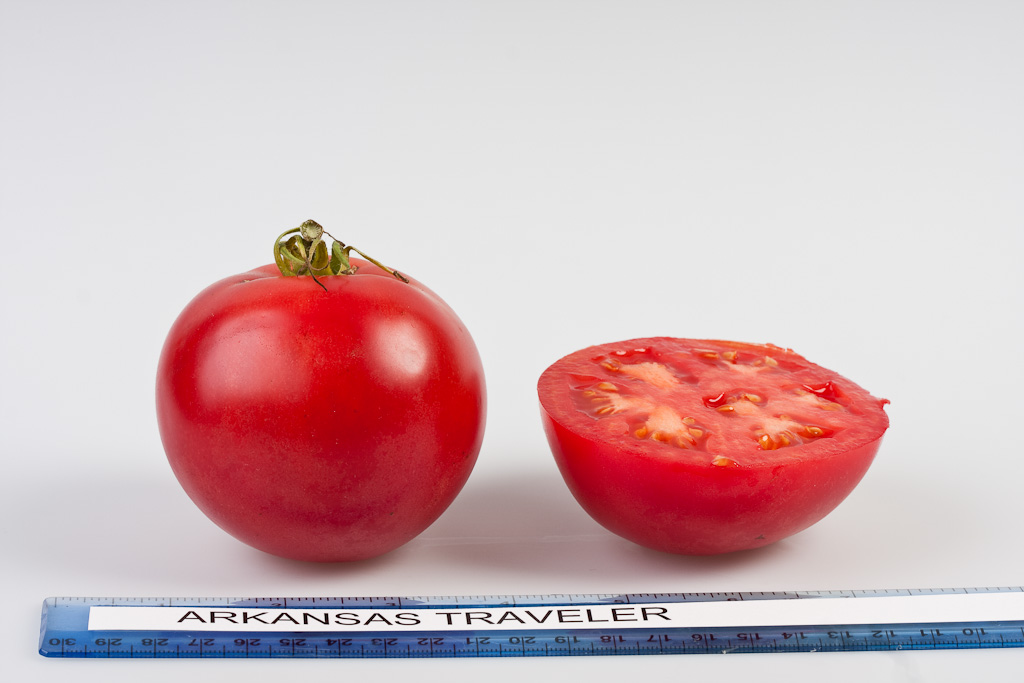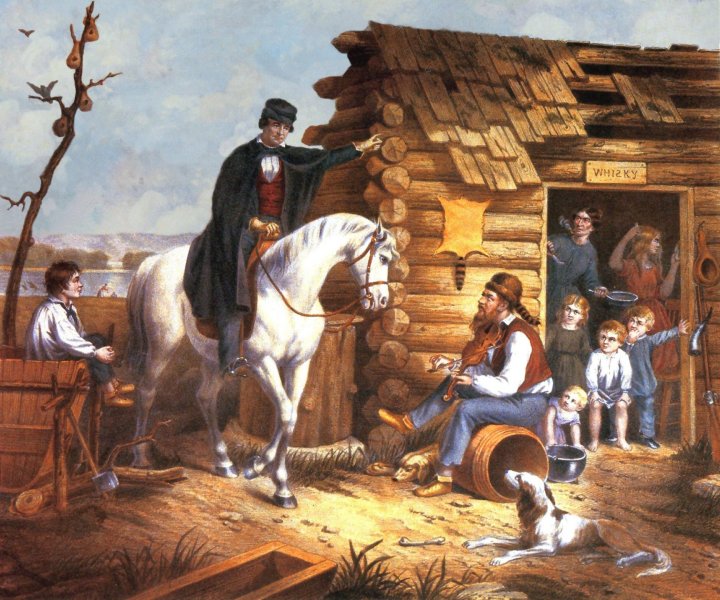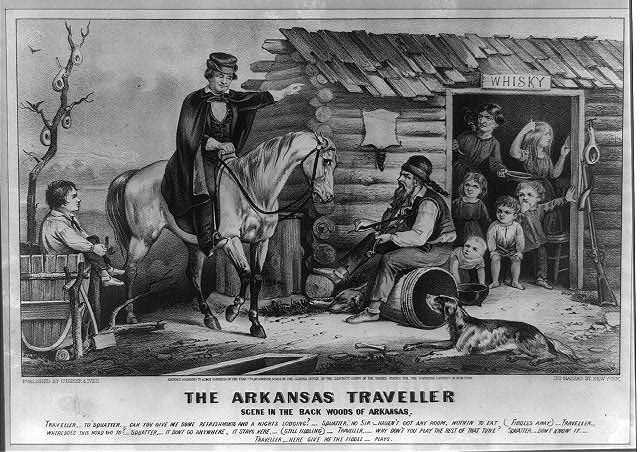In the Ozark Mountains of Arkansas, where I hail from, an heirloom tomato originated before the 1900’s. The Arkansas Traveler is prized for very flavorful, medium-sized tomatoes that resist cracking and keep on coming, even in drought and hot weather. Indeed, the Arkansas Traveler for these reasons became a mainstay tomato for much of the South. Take these user reviews of the tomato from a popular plant company
Great tomatoes for the South! These were one of the first tomato plants to produce tomatoes last year. They kept on producing when it got hot last summer and taste great.
I live in Houston where the heat and humidity boil through September, but the tomatoes continue on, although with less yield beginning in August. The flavor is awesome.
best producing plant ever
 Despite these positive testimonies the Arkansas Traveler has had a shady past.
Despite these positive testimonies the Arkansas Traveler has had a shady past.
Perhaps no other State in the Union has been so misrepresented as Arkansas. She has had much bad advertising, and the ignorant beyond her borders have wrong ideas of her and her people. By such people she is supposed to be the home of shiftless squatters, robbers, and cutthroats, who make the bowie-knife and the pistol the law of the land . . . “The Arkansas Traveler” is largely responsible for the wrong impression of our State.
How could a tomato do this kind of damage? Well the history is complicated.
In the mid-1800’s, most people knew “Arkansas Traveler” as a story with musical accompaniment (accompana, accompana, the fellow who plays the gee tar). The exact origins are unknown, but it was popularized by Arkansas native Colonel Sandy Faulkner, a teller of tall tales and fiddle player. Faulkner was the composer of the popular fiddle tune for “The Arkansas Traveler” which even became the state song of Arkansas from 1949–1963.
Oh, ’twas down in the woods of the Arkansaw,
And the night was cloudy and the wind was raw,
And he didn’t have a bed, and he didn’t have a bite,
And if he hadn’t fiddled, he’d a travelled all night.
But he came to a cabin, and an old gray man,
And says he, “Where am I going? Now tell me if you can.”
“Oh, we’ll have a little music first and then some supper, too,
But before we have the supper we will play the music through.
You’ll forget about your supper, you’ll forget about your home,
You’ll forget you ever started out in Arkansaw to roam.”
Now the old man sat a-fiddling by the little cabin door,
And the tune was pretty lively, and he played it o’er and o’er,
And the stranger sat a-list’ning and a-wond’ring what to do,
As he fiddled and he fiddled, but he never played it through.
Then the stranger asked the fiddler, “Won’t you play the rest for me?”
“Don’t know it,” says the fiddler. “Play it for yourself!” says he.
Then the stranger took the fiddle, with a riddy-diddle-diddle,
And the strings began to tingle at the jingle of the bow,
While the old man sat and listened, and his eyes with pleasure glistened,
As he shouted, “Hallelujah! And hurray for Joe!”
The abbreviated non-lyrical version (the full version is included below) is a lost wealthy traveler stumbles across a squatter’s cabin drawn by the sounds of a fiddle. The traveler requests food and shelter. The old squatter says they’ll get to supper after he finishes his tune. The trick is the tune keeps repeating with no apparent end. The traveler requests the end of the song, which the squatter claims to not know. The stranger takes the fiddle and ends the song. With the finished song, and elation of the squatter, the aforementioned food and shelter are more forthcoming. An Arkansas painter, Edward Payson Washbourne, eventually produced a piece that captured the story that became widely distributed and printed as a lithograph. But as quoting the historian Louise Hancox,
An Arkansas painter, Edward Payson Washbourne, eventually produced a piece that captured the story that became widely distributed and printed as a lithograph. But as quoting the historian Louise Hancox,
Yet less than thirty years later [Arkansas Traveler] produced shame, embarrassment, and despair. The painting, at first a source of state pride, was, by the turn of the twentieth century, blamed for sullying the image of Arkansas and discouraging immigration and investment.
Basically, the image of the squatter in a coon skin cap, outside a rustic cabin, whiskey written above the door, and with barefoot children in the doorway painted a picture of Arkansas as populations of yokels and hillbillies.
 In late 1849, an editorial in the Arkansas Intelligencer, lambasting the impact of the song and painting, read:
In late 1849, an editorial in the Arkansas Intelligencer, lambasting the impact of the song and painting, read:
People at a distance easily come to the conclusion that…a typical Arkansian is . . . a person in a semi-barbaric state, half alligator, half horse . . . armed to the teeth, bristling with knives and pistols, a rollicking daredevil type of personage, made up of coarseness, ignorance and bombast.
By the late 1800’s despite the love and hate relationship with the Arkansas Traveler, the name was bequeathed to a tomato cultivar. The exact origins of the Arkansas Traveler heirloom tomato are not actually known but it is known to be extinct. However, today a tomato cultivar is sold under the name Arkansas Traveler.
It’s important to understand what an heirloom plant actually is and is not. First, as the name suggests an heirloom must be old. Some authorities say heirloom vegetables are those introduced before 1951, when modern plant breeders introduced the first hybrids developed from inbred lines for commercial purposes. The other key here is that heirlooms are open pollinated by naturally by the wind, water, or critters. This is opposed to controlled pollination involving procedures, involving crazy scientists and breeders in secret evil lairs, to ensure all the seeds are descended from parents with known traits.
Two tomato experts, Craig LeHoullier and Carolyn Male, define heirloom tomatoes into four distinct categories.
- Commercial Heirlooms: Open-pollinated varieties introduced before 1940, or tomato varieties more than 50 years in circulation.
- Family Heirlooms: Seeds that have been passed down for several generations through a family.
- Created Heirlooms: Crossing two known parents (either two heirlooms or an heirloom and a hybrid) and dehybridizing the resulting seeds for how ever many years/generations it takes to eliminate the undesirable characteristics and stabilize the desired characteristics, perhaps as many as 8 years or more.
- Mystery Heirlooms: Varieties that are a product of natural cross-pollination of other heirloom varieties.
Again it is unclear where the original Arkansas Traveler heirloom tomato falls into these categories, other than just being old. The story complicates further because in the early 1970’s, scientists at the University of Arkansas developed two strains, which they named “Traveler” and “Traveler 76”. The later named for and introduced in 1976. “They are widely marketed as Arkansas Traveler because that name sounds older, more quaint and colorful.” This is of course why you do not find the Arkansas Traveler on my friend Jeff’s heirloom tomato website. And those lovely reviews of the Arkansas Traveler above aren’t even for the real heirloom tomatoes.
So as shifty as that old squatter, so too is the Arkansas Traveller tomato.
Photo above by Corey Burger on Flickr (cc)
The Story of the Arkansas Traveler
“In the earlier days of the territory of Arkansas, when the settlements were few and far between, an adventurous traveler from one of the old States, while traversing the swamps of that portion of the kedn’try, gets lost, on a cold, rainy day, in the autumn of the year. After wandering till evening, and despairing of finding a habitation, while searching for a place to camp, he strikes a trail which seems to lead somewhere, and also hears in that direction the noise of a fiddle. Accordingly he takes the trail and soon discovers, ahead of him, rising above the timber, a light column of smoke, which he knows comes from the cabin of a squatter. As he approaches, he finds it to be a log
cabin, ten logs high and about ten feet square— one side being roofed, and the other only half covered with boards. He also sees the proprietor seated on an old whisky-barrel, near the door, sheltered by a few boards which project from the eaves, playing a tune, or rather the first snatch of a tune, on an old fiddle.
After surveying the habitation and surroundings of ‘cotton head’ children, the traveler rides up to see if he can get lodgings; and the following dialogue ensues. The hoosier, however, still continuing to play the same part over and over again, only stopping to give short, indifferent replies to the traveller’s queries:
Traveller: Good Morning, Sir!
Squatter: How d’ye do, Sir?
Trav.: Can I get to stay all night with you?
Squat: No, Sir.
Trav.: Can’t you give me a glass of something to drink; I’m very wet and cold?
Squat.: I drank the last drap this morning.
Trav.: I am very hungry; ain’t had a thing to eat to-day. Will you let me have something to eat?
Squat.: Hav n’t a darned thing in the house.
Trav.: Then can’t you give my horse something?
Squat.: Got nothing to feed him on.
Trav.: How far is it to the next house?
Trav.: Stranger, I do n’t know; I’ve never been there.
Trav.: Well, where does this road go to?
Squat.: It’s never been anywhere since I’ve lived here; it’s always here when I get up in the morning.
Trav.: As I am not likely to get to any other house to-night, can’t you let me sleep in yours, and I’ll tie my horse to a tree and do without anything to eat or drink?
Squat.: My house leaks; there’s only one dry spot in it, and me and Sal sleeps on that.0
Trav.: Why do n’t you finish covering your house and stop the leaks?
Squat.: It’s raining.
Trav.: Well, why do n’t you do it when it is not raining?
Squat.: It do n’t leak then.
Trav.: Well, as you have nothing to eat or drink in your house, and nothing alive about your place but children, how do you do here, anyhow?
Squat.: Putty well, I thank you. How d’ye do yourself?
Trav.: (After trying in vain all sorts of ways to extract some satisfactory information from him.) My friend, why do n’t you play the whole of that tune?
Squat.: (Stops playing and looks up for the first time.) I did not know there was any more to it. Can you play the fiddle stranger?
Trav.: I play a little, sometimes.
Squat.: You do n’t look much like a fiddler, (handing him the fiddle.) Will you play the balance of that tune?
The traveler gets down and plays the tune.
Squat.: Stranger, come in! Take a half dozen chairs and sit down. Sal, go round into the holler, where I killed that buck this morning. Cut off some of the best pieces and fetch it, and cook it for me and this gentleman, directly. Raise up the board under the head of the bed, afore you go, and get the old black jug I hid from Dick, and give us some whisky—I know there’s some left yet. Dick, carry the gentleman’s horse round to the shed; you’ll find some fodder and corn there. Give him as much as he can eat. Durn me, stranger, if you can’t stay as long as you please, and I’ll give you plenty to eat and drink. Hurry, old woman. If you can’t find the butcher-knife, take the cob-handle, or granny’s knife. Play away, stranger! You shall sleep on the dry spot tonight.
After about two hours’ fiddling and some conversation, in which the squatter shows his characteristics, the stranger retires to the ‘dry spot.’”
